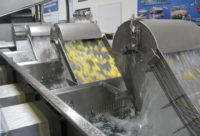
MBC's energy management strategy does not only involve natural gas. Coal availability and quality as well as electric power pricing are important variables. "Electric power prices in many cases are now driven by the price of natural gas," says DeLuca. Corporate engineering pays close attention to the electric tariffs chosen for its breweries, which operate in six different states, each with its own regulations and tariffs. MBC also keeps an eye out for state government energy initiatives that reward manufacturers for reduced energy consumption. Reduced energy use is also a component of MBC's corporate-wide sustainability initiative. MBC supports green power by being the largest purchaser of green power in the city of Milwaukee as well as working to develop other green power projects.
The company develops a strategy for controlling each source of primary energy. Individual strategies are developed for natural gas, coal, and electric power. The ability to reschedule production is constrained by seasonal product demand so MBC's energy consumption inevitably reflects seasonality. But the company has adjusted some energy intensive operations to off-peak hours in order to smooth out the electric power demand.
It is also improving the way it controls production equipment as well as the installation of newer or improved equipment for higher energy efficiency. MBC also looked carefully at long-term performance trends for large energy conversion systems like boilers. With the run-up in natural gas prices, larger capital investments such as new more efficient boilers have become much more attractive. Breweries generate electricity, and in some of MBC's breweries advanced control of the generation plant is being employed today. Control systems in some of these breweries compare hourly and daily price points for power and fuel to set electricity generation levels. Refrigeration is a major energy user within the brewery. MBC has improved sequencing of its refrigeration systems to optimize the brewery energy profile and continuously monitors the head pressure of its refrigeration systems.
An ongoing component of MBC's energy strategy is to obtain progressively more granular information about energy consumption. "The detail of the information we have now varies from one brewery to another, but our long-term goal is to install progressively more granular energy metering everywhere," says DeLuca. "We have an energy champion in most of our breweries and the breweries already have brought up a lot of good ideas for saving energy."
Another part of DeLuca's role is to work with corporate purchasing to manage MBC's purchasing strategy for coal and natural gas and to work with the breweries as they negotiate tariffs with their electric utilities. Like all energy consumers, MBC is feeling the heat from the run-up in energy prices. "In Wisconsin, we have had a 22 percent increase in the price of electricity since 1998. In Texas, deregulation hasn't helped us because the market price of electricity is driven by high natural gas prices and congestion in the electric transmission system. " The run-up in energy prices continues. MBC maintains an updated three-to-five-year plan for capital improvement in each brewery. With the price of energy skyrocketing, energy-related capital improvements look more and more attractive.
